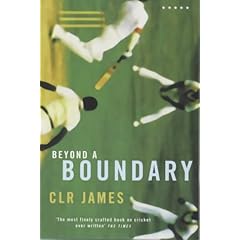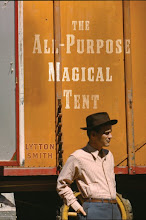
According to, well,
the Associated Press,
artist-in-the-news Shepard Fairey is suing them because they try to sue him over the correspondences between the above photograph (left) and Fairey's poster (right - directions added for the benefit of the AP).
In the blue corner, the AP says that the photographers who create art through taking pictures have a right to ownership and use of that art; in the red(, white, and blue) corner, Fairey contends that his poster amounts to fair use and, appropriately (or appropriatingly) has retained Anthony Falzone, executive director of Stanford’s Fair Use Project, to argue his case.
The legal intricacies of ownership and copyright I'll leave to the law courts, but what intrigues me about this is an
interview Print Magazine conducted with artist Milton Glaser. A couple of excerpts:
PM: How does one distinguish between plagiarism and reference?
MG: The process of looking back at the past is very accepted in our business—the difference is when you take something without adding anything to the conversation.
We celebrate influence in the arts, we think it’s important and essential. But imitation we have some ambivalence about, especially because it involves property rights. It probably has something to do with the nature of capitalism. We know that in other cultures, Chinese culture for instance, imitation is seen as a tribute, because you wouldn’t bother imitating trivial works. But in those cases the influence is acknowledged and the skill required is obvious.
For myself—this is subjective—I find the relationship between Fairey’s work and his sources discomforting. Nothing substantial has been added.
and, from a little later in the interview:
MG: what’s most important to the graphic arts is communicating clearly, and sometimes that means using the vernacular of the moment. For the fine arts, the most important thing is being personally expressive. There aren’t that many unique voices in the world.
Glaser's sense of discomfort obviously stems from his strong and avowedly capitalist ideas of ownership, and that seems to place him in a very different camp from Fairey, whose work as a street artist and often-stated views on (street) art as a force for social change suggest, well, a less capitalist standpoint.
That the two have different political and artistic views is fine, of course. What is troubling - setting aside Glaser's construction of Chinese culture as invested in imitation while American culture is not, a painting with broad brush-strokes which doesn't do justice to artists in either China or the US - is that Glazer falls back on the idea of "unique voices" and the need to be "personally expressive."
I'm not so sure we can align those two concepts, in any art, especially where social change is a goal, rather than the maintaining of the status quo. Fairey's poster operates in several directions: it provides a symbol around which a community for political change could cohere; it allows for a questioning of what happens when colour is foregrounded during an election, subtly by the erasure of skin colour in favour of the "national" colours; it offers a commentary on "hope" as a political aim or opt-out; and it also asks that we consider issues of celebration and replication. When the image of one person becomes ubiquitous, what happens to the ideas of individuality, communal understanding of socio-political direction, and the ways we construct those we interact with, especially through the distancing lenses of the media.
In effect, Fairey's piece, for all its questioning, is and should be read as discomforting: not for the way it appropriates a photograph, but for the way it both covers over and discovers President Obama, making visible a double process that is also happening in the photograph the AP used, but which we can't so easily see in that more everyday snap. David Hockney once quipped that "photography is all right if you don't mind looking at the world from the point of view of a paralysed cyclops - for a split second," and while this isn't a critique of photography (an art form I love) I do want to suggest media acceptance of media-generated images remains too unquestioned, too aware of its own split-second paralysis.
Fairey's piece allows us to ask some important questions about how we view individuals within social and political contexts, and whether we've taken into account our own projections as well as their performances of identity. Glaser's critique assumes that art represents a true personal, rather than the way we are each the product of competing and often incompatible influences. Glaser, whose company is called Milton Glaser, Inc, should recognize that such construction underlies and undermines the myth of the personally expressive; then again, if you can found a company named after yourself, perhaps you're so invested in the public image of the self that you can't recognizes it, too, is a photograph, a split-second.
The idea that art represents a unique voice is an all-too-oft-repeated assumption of a certain school or set of schools of art, reflecting a geographical and historical bias that ignores other cultures and times. China enters into Glaser's critique as monolithic and only worth mentioning as an outlying reference point; the English medieval notion that an author compiled, rather than invented, gets ignored. The effect, however, is not simply an aesthetic difference, one camp valuing originality, the other collaboration and reference. In maintaining the idea of the "unique voice," art threaten to removes the social through presenting a hierarchy, the haves versus the have-nots, those who have made it and those who have not. That's a limited and limiting portrayal which doesn't allow art to be fully social or fully an agent from social change in the way I think Fairey sees (and seizes) it: by acknowledging that art proceeds by imitation and intervention, by copying and altering, Fairey reminds us that anyone can become an artist in the way a society needs at a particular point in time. That is, someone gets to enter into and rethink a set of aesthetic assumptions, in order to redirect society, starting with the individual and not the elite.
Whether or not Fairey wins his case, it nevertheless serves to highlight the importance of what his project is doing.


